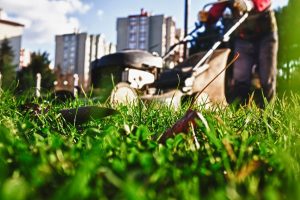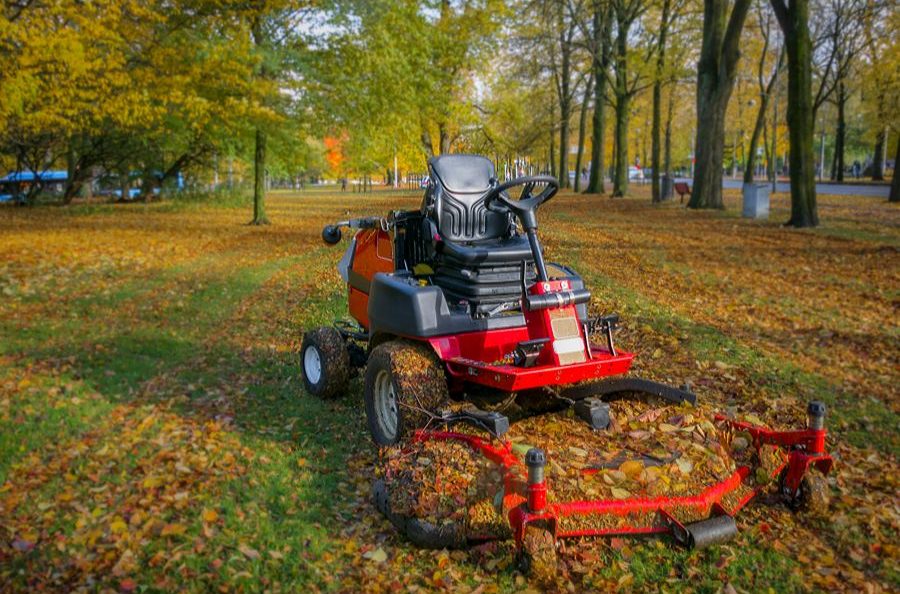Autumn is a beautiful season- until you have fallen leaves marring your perfect lawn. Moreover, they can suffocate your grass if left unattended for too long. One efficient method for leaf removal during fall cleanup is using a lawn mower. Not only does it clear your lawn, but it also mulches the leaves. So, in the long run, it provides beneficial nutrients to your soil.
Now, the question of the century is: How can you pick up leaves with a lawn mower and maintain your garden? Don’t worry; we’ve got you covered.
How To Pick Leaves With a Lawn Mower
Handling leaves on your lawn is daunting, especially during the peak of fall. However, your trusty lawn mower will double up as an effective leaf-handling machine.
Two simple methods that draw considerable interest are the “Mow and Bag” and “Mulching” techniques. Each method has advantages, and the choice depends on your equipment and how you’d like to manage your yard waste.
Mow and Bag
This technique is as straightforward as it sounds. As you mow your lawn, an attached bag collects the leaves, which may be disposed of or composted.
For those with larger lawns, using a riding mower with a bagging attachment makes this task far less strenuous. The leaf bags connected to the riding mower attachment hold many leaves. Thus reducing the number of times you need to stop and empty them.
If your riding mower doesn’t have a bagging attachment, you may use leaf vacuum riding mower attachments. They are specially designed to suck up leaves and typically attach to the riding mower’s discharge chute to collect them effectively. With this setup, you’ll effectively turn your riding mower into a large-scale leaf vacuum.
Mulching
Mulching involves cutting leaves into smaller pieces that decompose more quickly. This process provides nutrients back to the soil.
Many modern mowers come with a mulching feature. But you can also attach a mulching blade to your existing mower, whether a push or a riding mower.
Mulching blades are designed to chop leaves and grass clippings into finer pieces that may be left on the lawn to decompose naturally.
For those with riding mowers, special mulching riding mower attachments are available. These attachments further chop the leaves that pass through the mower’s blades.
Optional- Push Lawn Sweepers and Leaf Vacuums
If you have a smaller lawn or specific areas that are hard to reach with a riding mower, push lawn sweepers are a useful supplemental tool. These manually operated devices pick up leaves effectively and can be a good alternative or supplement to using a mower.
Leaf vacuums are also an option for areas where leaves accumulate more densely. While these don’t attach to mowers, they are useful tools in your leaf collection arsenal, particularly for getting leaves out of tight spots or flower beds.
Types of Lawn Mowers Suitable for Picking Up Leaves
Gas-Powered Rotary Mowers
- How They Work: These mowers have a horizontally spinning blade that chops and lifts leaves into a bag or disperses them back onto the lawn.
- Suitable For: Small to medium-sized yards and uneven terrains.
- Additional Attachments: Many come with options for bagging attachments.
- Pros: Versatile, powerful, and can tackle thicker leaf layers.
- Cons: Noisy and emits exhaust fumes.
Electric Rotary Mowers
- How They Work: Functionally similar to gas-powered rotary mowers but use electric or battery power.
- Suitable For: Smaller lawns or for those who prefer an eco-friendly option.
- Additional Attachments: Bagging and mulching options are often available.
- Pros: Quieter and more environmentally friendly.
- Cons: Limited by the range of the electrical cord or battery life.
Mulching Mowers
- How They Work: These mowers keep leaves under the deck longer, allowing for a finer chop.
- Suitable For: Those wanting to enrich their soil by mulching the leaves back into the lawn.
- Additional Attachments: Generally built-in; no need for extra attachments.
- Pros: Very efficient at creating fine mulch that decomposes quickly.
- Cons: Higher upfront costs may not be suitable for significant leaf accumulations.
Riding Mowers
- How They Work: A more extensive, ride-on version of rotary mowers. These cover more ground quickly and usually come with powerful engines.
- Suitable For: Large lawns or estates.
- Additional Attachments: Many are fitted with bagging, mulching, or vacuum attachments.
- Pros: Fast and efficient for large areas, comfortable to use.
- Cons: Expensive, require a lot of storage space, and unsuitable for uneven terrain.
Robotic Lawn Mowers
- How They Work: Just like robots that harvest tomatoes, automated mowers are programmed to mow within a defined area.
- Suitable For Smaller, relatively flat areas and for those who prefer a ‘set it and forget it’ approach.
- Additional Attachments: Generally not available.
- Pros: Minimal manual effort required, eco-friendly options available.
- Cons: Not efficient for leaf collection unless combined with other leaf management techniques.
Self-Propelled Mowers
- How They Work: These push mowers include a motor to propel the wheels, making mowing easier.
- Suitable For: Medium-sized yards, especially those with slopes.
- Additional Attachments: Bagging and mulching options are usually available.
- Pros: Easier to maneuver, good for yards with hills.
- Cons: More expensive than basic push mowers and can be heavier.
Steps to Pick Up Leaves With a Lawn Mower
Step 1- Prepare Your Lawn
First, survey the area by walking through your yard to identify large objects like rocks or branches that could damage the mower.
Afterward, remove obstacles. You can use a rake or your hands to remove these objects. The smoother the surface, the easier and safer the job will be.
Step 2- Check the Lawn Mower
After preparing the lawn, inspect the Mower. Check the mower blades, belts, and other moving parts to ensure they work well.
If your mower has a bagging or mulching attachment, ensure it’s properly secured. Also, confirm that the blades are appropriate for your task—mulching blades and regular blades for bagging.
Step 3- Adjust the Blade Height
Check that the blade is set one or two notches above the setting you usually use for mowing grass. And always test a Patch to confirm the blade settings. That is, mow a small, less visible area first to ensure the height is appropriate for picking up leaves without scalping the grass.
Step 4- Mow in Rows
Plan your path to boost efficient coverage. A zigzag pattern or spiraling from the outside are effective strategies. Furthermore, overlapping a few inches with each pass ensures you pick up leaves effectively, leaving no patches.

Step 5- Monitor Bag or Container
Of course, you need to keep an eye on the bag or container if you’re using a bagging attachment. That way, you can empty when full. Note that overloading leads to spills or even damage to the mower. So, pause your work to empty the bag when it’s full.
Step 6- Mulching (Optional)
If you’re planning to mulch, a second pass might be necessary to break down the leaves into finer pieces. Then, check effectiveness. To do this, walk around to see if the mulched leaves are adequately dispersed. If they’re still too big, you might need another pass.
Step 7- Clean Your Equipment
Always remove any leaf debris from the mower’s blades and underside. Also, check the attachments. If you used a bagging attachment, empty and clean it to ensure it’s ready for your next mowing task.
Step 8- Store Properly
Finally, dry and store. Wipe down your mower and any attachments and dry them before storing them to prevent rust and mildew.
When Should You Use a Lawn Mower to Pick Up Leaves on Your Lawn?
Seasonal Timing
Fall is the quintessential season for leaf removal, as trees typically shed their leaves. If you have a large lawn covered in leaves, consider using lawn tractor leaf collectors for a more efficient cleanup. These tractor attachments cover a wider area in less time than a traditional push mower.
Weather Conditions
Dry weather is ideal when picking up leaves. Dry leaves are much easier to handle across all devices, from leaf blowers to tow-behind yard vacuums. Wet leaves often clump together and even mingle with grass clippings, creating a mess that’s harder to clean. Let’s not forget the fact that they can clog your machinery.
Composting Considerations
If your end goal is to turn leaves into a compost pile, it’s best to plan your mowing when the leaves are dry. Dry leaves and grass clippings are easier to move and integrate into your compost setup. They also decompose more readily, speeding up the composting process.
Grass Height Matters
The height of your grass also has a level of influence on when you should tackle leaf collection. If the grass needs mowing, that’s a good time to pick up leaves. Tow-behind mower attachments like lawn vacuums may collect grass clippings and leaves efficiently. This makes the most out of your yard work efforts.
Handling More Than Just Leaves
If your yard is littered with more than leaves, such as flower petals, lawn sweepers might be the tool for you. These attachments can handle a range of debris types. They can also be a versatile addition to your lawn care arsenal. However, a lawn sweeper’s smaller hopper might not be suitable for larger debris.
Leaf Types and Equipment Choices
The types of leaves on your lawn may affect your timing and tool choice. Some leaves are more stubborn and decompose more slowly.
For these, you might need specialized equipment like tow-behind lawn vacuums to ensure effective removal.
In A Nutshell
Leaf management can be effortless when you equip yourself with the right tools. Whether your riding mower attachment interests focus on bagging or mulching, or you prefer the brute force of a leaf blower for clearing pathways, there’s a tool for every need.
For large yards, a tow-behind lawn vacuum offers quick and efficient cleanup. Meanwhile, a lawn sweeper’s smaller hopper may get the job done for more intricate space cleanup. It’s all about using the best approach that aligns with your lawn’s specific conditions and yard maintenance goals.

